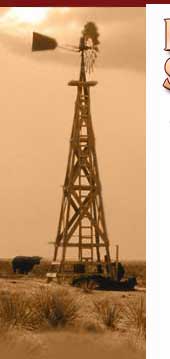|
The journey to recovery of the range after drought
Roger Gates, Extension Range Specialist, SDSU

Roger Gates, range specialist, said as a society we need to think hard about how we approach drought assistance. The temptation to accept feed subsidies provides incentive for poor management or overstocking. "We need to find incentives that are not based on current inventory," he said. |
Drought may be a difficult reality of raising cattle, and being able to recover from it is essential to remaining in the beef industry, Roger Gates told attendees at the 2003 Range Beef Cow Symposium in Mitchell, Neb., Dec. 10. "A realistic understanding of drought is essential for appropriate planning and response when rainfall is short."
The South Dakota State University (SDSU) Extension range specialist described how average rainfall is calculated, explaining that it includes rainfall from years when it is above normal and more years when it is below normal.
"We think easily about average precipitation; but, in fact, that is not a good index," he said. "[Average precipitation] is higher than the actual precipitation that we are going to get most years."
Gates pointed out that the 1990s formed one of the wettest periods since precipitation has been recorded. Management and stocking decisions may have been different during that time, and now producers are having to recover from those decisions.
"Exceptionally dry years should not be unexpected. Cyclic drought is characteristic of arid and semi arid areas of the world," Gates stated. "Viewing drought as unusual or as a crisis is not realistic."
High-range condition — which includes diversity of desirable plants coupled with healthy soil conditions — should be one goal of recovery for rangeland managers, he said.
"One of the best indicators of seasonal production is the precipitation in April, May and June," Gates said. If rangeland managers can look at this as an indicator and don’t wait until September to recognize a drought, they can de-stock early to preserve range condition.
"At high-range condition, you can produce as much forage as you do from low-range condition in wet years," Gates added.
To manage for high-range condition, producers can take important steps in developing a plan for recovery. Gates summarized components of a drought-recovery plan, advising rangeland managers to:
1) anticipate below-normal rainfall,
2) de-stock promptly,
3) be willing to exchange short-term losses for long-term gains, and
4) restock gradually.
Biological principles are useful when recovering from drought. Gates pointed out the widely stated "take half, leave half" principle. Soil cover, wind barriers, nutrient pools, snow capture and feed reserves are all reasons for leaving forage.
Establishing a feed "budget" may be the single most important key in recovery, Gates said. Inventorying range and other feed sources and projecting animal inventory are elements of a feed budget. It’s vital to match supply with demand.
"Careful management of the range resource is only one of the attributes necessary for a successful range cow enterprise," Gates said, "but it is foundational."
Management practices, Gates said, that promote recovery and avoid defoliation are: resting the range for an entire year, using winter grazing only, using the range only early in the grazing season, deferring use until target species have mature seed, and using rangeland in late spring (if growth is abundant) and removing animals before the boot stage.
The key message, Gates said, is not to forget to keep an eye on your final destination. Looking at the complete ranch picture is important to manage for high-range condition.
— by Corinne Patterson
Click here to download the presentation (in pdf format).
 You will need Acrobat Reader to view. You will need Acrobat Reader to view.
Click the image to download a free copy.
Click here to listen to the presentation
You will need Windows Media Player to listen in.
Click here to download a free version.
|
